|
A log cabin is a house built
that is literally built from logs - and no more pleasant a construction
can we imagine. It is a fairly simple type of log built house. A distinction
has to be drawn between the traditional meanings of "log cabin" and "log house." Historically most "log cabins" were a simple one- or 1½-story structures, somewhat impermanent, and less finished or less architecturally sophisticated than
the later log houses. A "log cabin" was usually constructed with round rather than hewn, or hand-worked,
logs and often it was the first generation home building erected quickly for frontier shelter.
Yeehaw. That's the spirit.
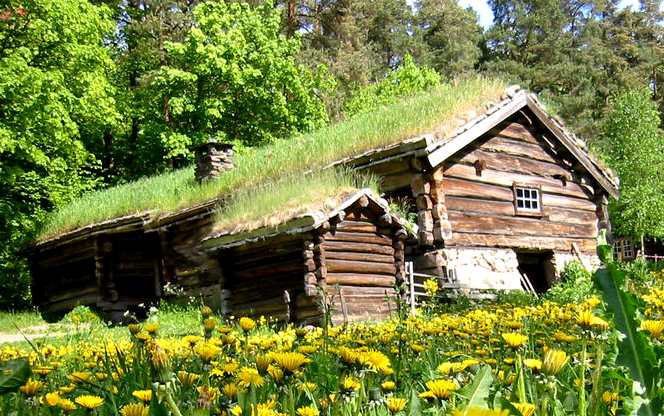
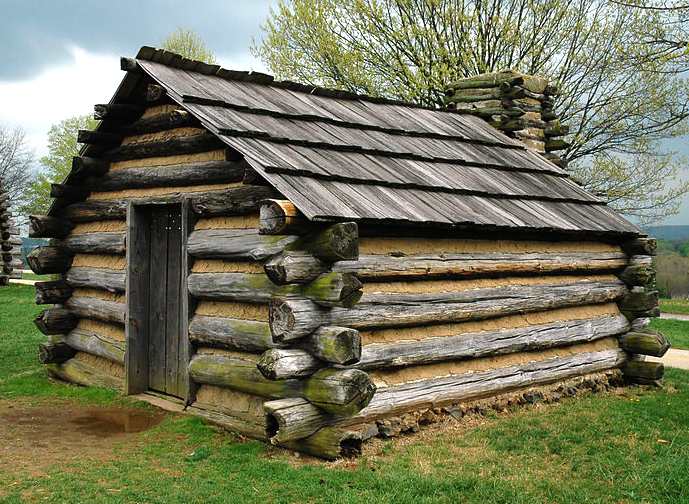
Log
cabins blend into their country surroundings
EARLY EUROPEAN HISTORY
Construction with logs was described by Roman architect Vitruvius Pollio in his architectural treatise De Architectura. He noted that in Pontus (modern-day Romania, former Roman Empire province Dacia) dwellings were constructed by laying logs horizontally overtop of each other and filling in the gaps with "chips and mud".
Historically log cabin construction has its roots in Scandinavia and Eastern Europe. Although their origin is uncertain, the first log structures were probably built in Northern Europe in the Bronze Age (about 3500 BC). By the time Europeans began to settle in North America, they had a long tradition of using logs for houses, barns, and other outbuildings in the Scandinavian countries, Germany, Northern Russia and Ukraine.
The Wood Museum in Trondheim, Norway, displays fourteen different traditional profiles, but a basic form of log construction was used all over North Europe and Asia. Early settlers used such methods of log building in North America. It became a popular form of construction for pioneers' settling in the far north and the more mountainous parts of United States and Canada, where winter conditions were often extreme.
Log construction has been especially popular in Scandinavia, where straight tall tree trunks (pine and spruce) are readily available. With suitable tools, a log cabin can be erected from scratch in days by a family. As no chemical reaction is involved, such as hardening of mortar, a log cabin can be erected in any weather or season. Many older towns in Northern Scandinavia have been built exclusively out of log houses, which have been decorated by board paneling and wood cuttings. Today construction of modern log cabins as leisure homes is a fully developed industry in Finland and Sweden.
CONSTRUCTION
Log cabins were constructed with either a purlin roof structure or a rafter roof structure. A purlin roof consists of horizontal logs that are notched into the gable-wall logs. The latter are progressively shortened to form the characteristic triangular gable end. The steepness of the roof was determined by the reduction in size of each gable-wall log as well as the total number of gable-wall logs. Flatter roofed cabins might have had only 2 or 3 gable-wall logs while steeply pitched roofs might have had as many gable-wall logs as a full story. Issues related to eave overhang and a porch also influenced the layout of the cabin.
The decision about roof type often was based on the material for roofing like bark. Milled lumber was usually the most popular choice for rafter roofs in areas where it was available. These roofs typify many log cabins built in the 20th century, having full-cut 2×4 rafters covered with pine and cedar shingles. The purlin roofs found in rural settings and locations, where milled lumber was not available, often were covered with long hand-split shingles.
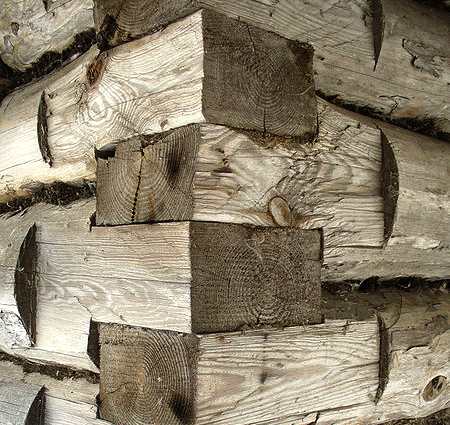
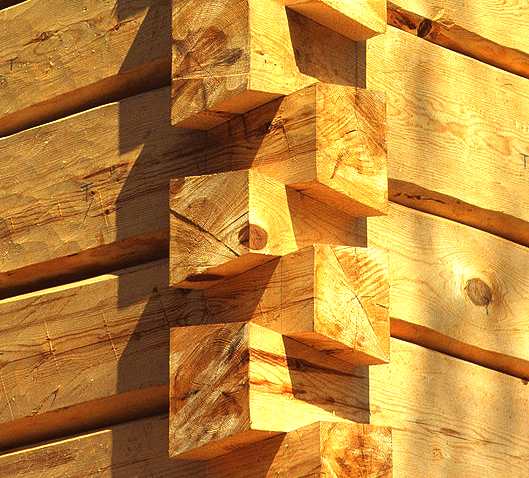
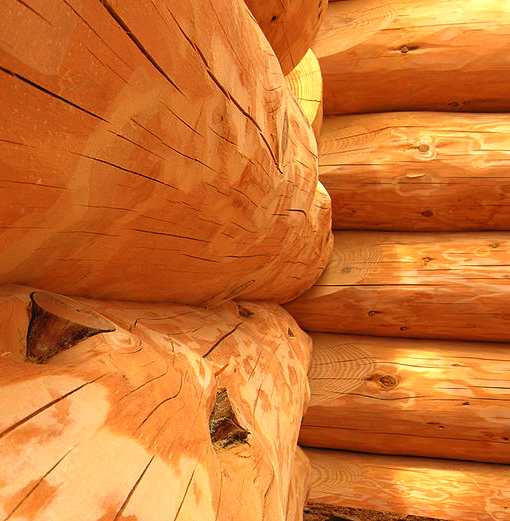
Corner
joint techniques - there's a lot of skilled work here
UNITED STATES PIONEERS
In the present-day United
States, settlers may have first constructed log cabins in 1638. Historians believe that the first log cabins built in North America were in the Swedish colony of Nya Sverige (New
Sweden) in the Delaware River and Brandywine River valleys. Many of its colonists were actually Forest Finns, because Finland was controlled by Sweden at that time. The Swedish colony only lasted a couple of decades before it was absorbed by the Dutch colony of New Netherland, which was soon absorbed by the English. Most of the descendants of the Swedish-Finnish colony are believed to have stayed in North America. Their quick and easy construction techniques not only remained, but spread.
Later German and Ukrainian immigrants also used this technique. The Scots and Scots-Irish had no tradition of building with logs, but they quickly adopted the method. The first English settlers did not widely use log cabins, building in forms more traditional to them.[ Few log cabins dating from the 18th century still stand, but they were not intended as permanent dwellings. Possibly the oldest surviving log house in the United States is the C. A. Nothnagle Log House (ca. 1640) in New Jersey. When settlers built their larger, more formal houses, they often converted the first log cabins to outbuildings, such as chicken coops, animal shelters, or other utilitarian purposes.
When cabins were built with the intention of applying siding, the logs were usually hewed on the outside to facilitate the application of the siding. When logs were hewed on the inside as well, they were often covered with a variety of materials, ranging from plaster over lath to wallpaper.
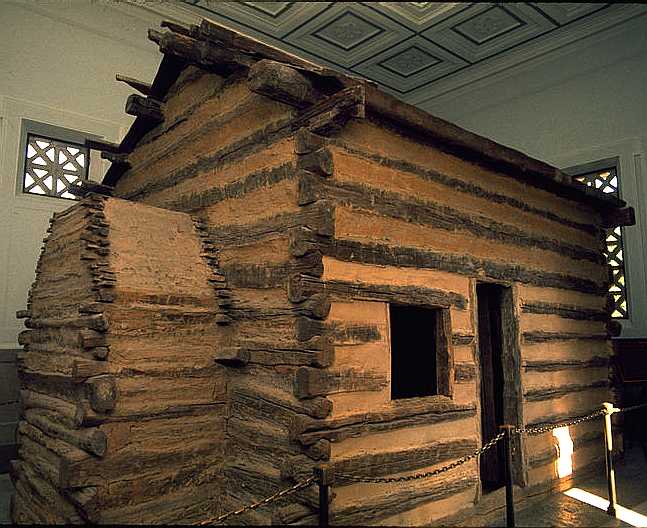
Once
of the most famous pioneering log cabins - Abraham Lincoln's birthplace
TRADITIONAL NORTH AMERICAN LOG HOMES
Log cabins were built from logs laid horizontally and interlocked on the ends with notches (British English cog joints). Some log cabins were built without notches and simply nailed together, but this was not as structurally sound. Modern building methods allow this shortcut.
The most important aspect of cabin building is the site upon which the cabin was built. Site selection was aimed at providing the cabin inhabitants with both sunlight and drainage to make them better able to cope with the rigors of frontier life. Proper site selection placed the home in a location best suited to manage the farm or ranch. When the first pioneers built cabins, they were able to "cherry pick" the best logs for cabins. These were old-growth trees with few limbs (knots) and straight with little taper. Such logs did not need to be hewn to fit well together. Careful notching minimized the size of the gap between the logs and reduced the amount of chinking (sticks or rocks) or daubing (mud) needed to fill the gap. The length of one log was generally the length of one wall, although this was not a limitation for most good cabin builders.
Decisions had to be made about the type of cabin. Styles varied greatly from one part of the US to another: the size of the cabin, the number of stories, type of roof, the orientation of doors and windows all needed to be taken into account when the cabin was designed. In addition, the source of the logs, the source of stone and available labor, either human or animal, had to be considered. If timber sources were further away from the site, the cabin size might be limited.
Cabin corners were often set on large stones; if the cabin was large, other stones were used at other points along the sill (bottom log). Since they were usually cut into the sill, thresholds were supported with rock as well. These stones are found below the corners of many 18th-century cabins as they are restored. Cabins were set on foundations to keep them out of damp soil but also to allow for storage or basements to be constructed below the cabin. Cabins with earth floors had no need for foundations.
Cabins were constructed using a variety of notches. Notches can vary within ethnic groups as well as between them. Notches often varied on a single building, so their styles were not conclusive. One method common in the Ohio River Valley in southwestern Ohio and southeastern Indiana is the Block House End Method an example of this is found in the David Brown House.
Some older buildings in the United States Midwest and the Canadian Prairies are log structures covered with clapboards or other materials. Nineteenth-century cabins used as dwellings were occasionally plastered on the interior. The O'Farrell Cabin (ca. 1865) in Boise, Idaho had backed wallpaper used over newspaper. The C.C.A. Christenson Cabin in Ephraim, Utah (ca. 1880) was plastered over willow lath.
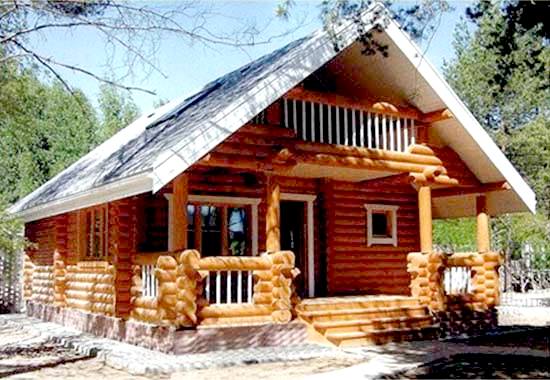
Log cabins reached their peak of complexity and elaboration with the Adirondack-style cabins of the mid-19th century. This style was the inspiration for many United States Park Service lodges built at the end of the 19th century and beginning of the 20th century. Log cabin building never died out or fell out of favor. It was surpassed by the needs of a growing urban United States. During the 1930s and the Great Depression, the Roosevelt Administration directed the Civilian Conservation Corps to build log lodges throughout the west for use by the Forest Service and the National Park Service. Timberline Lodge on Mount Hood in Oregon was such a log structure, and it was dedicated by President Franklin D. Roosevelt.
In 1930, the world's largest log cabin was constructed at a private resort in Montebello, Quebec, Canada. Often described as a "log château", it serves as the Château Montebello hotel.
The modern version of a log cabin is the log home, which is a house built usually from milled logs. The logs are visible on the exterior and sometimes interior of the house. These cabins are mass manufactured, traditionally in Scandinavian countries and increasingly in eastern Europe. Squared milled logs are precut for easy assembly. Log homes are popular in rural areas, and even in some suburban locations. In many resort communities in the United States West, homes of log and stone measuring over 3,000 sq ft (280 m2) are not uncommon. These "kit" log homes are one of the largest consumers of logs in the Western United States.
Crib barns were a popular type of barn found throughout the U.S. south and southeast regions. Crib barns were especially ubiquitous in the Appalachian and Ozark Mountain states of North Carolina, Virginia, Kentucky, Tennessee and Arkansas.
In Europe, modern log cabins are often built in gardens and used as summerhouses, home offices or as an additional room in the garden. Summer houses and cottages are often built from logs in northern Europe.
Chinking refers to the mortar/infill material between the logs in the construction of log cabins and other log-walled structures. Traditionally, dried mosses, such as Pleurozium schreberi or Hylocomium splendens, were used in the Nordic countries as an insulator between logs.
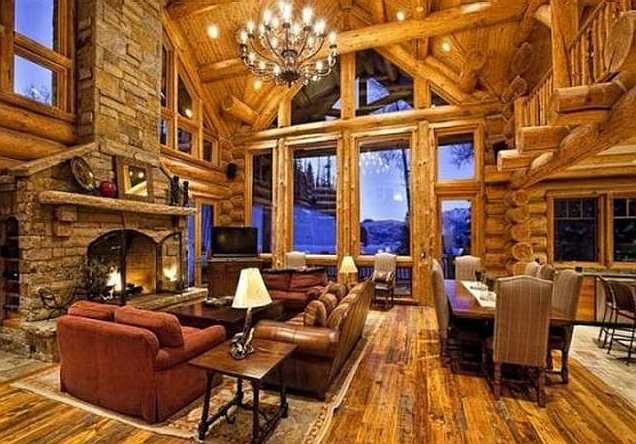
PIONEERING SYMBOLISM
The log cabin has been a symbol of humble origins in US politics since the early 19th century. Seven United States Presidents were born in log cabins, including Abraham Lincoln, Andrew Jackson, and James Buchanan. Although William Henry Harrison was not one of them, he and the Whigs during the 1840 presidential election were the first to use a log cabin as a symbol to show North Americans that he was a man of the people. Other candidates followed Harrison's example, making the idea of a log cabin—and, more generally, a non-wealthy background—a recurring theme in campaign biographies.
More than a century after Harrison, Adlai Stevenson acknowledged: "I wasn’t born in a log cabin. I didn’t work my way through school nor did I rise from rags to riches, and there’s no use trying to pretend I did." Stevenson lost the 1952 presidential election in a landslide to Dwight D. Eisenhower.
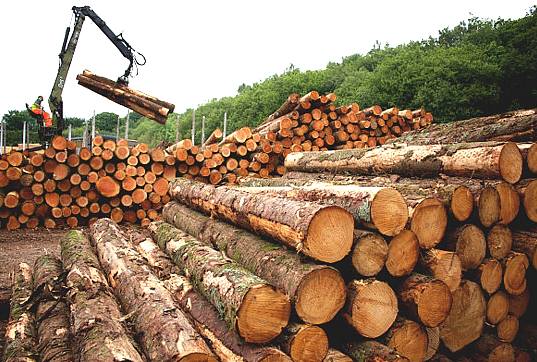
The
Forestry Commission in England supports the use of sustainable timber in construction and as a source of renewable energy. This
website will allow you to find out more about Forestry Commission projects that use locally grown sustainable timber and about how
they promote timber as a renewable and sustainable material.
Pre-historic and historic clearance of our woodland led us to a low
point at the beginning of the twentieth century when woodland was only
5% of Britain – and falling. It is now nearly 12% - and rising.
Through creating this major new asset, we can be sure of handing on to
future generations something better than we inherited. As a result of
major investments in processing capacity during the last 20 years, the
industry has been independently estimated as providing over £7 billion
annually to UK GDP, and directly employs some 167,000 people in growing,
harvesting and processing trees across the UK.
QUNGDAO
ENLIGHTENING ELECTROMECHANICAL CO LTD
A
leading plywood and wooden pallet factory from china with a good
reputation in Europe, America and Asia. QEE manufacture all kinds of all
kinds of wooden pallet. Okoume plywood, Plywood for furniture usage,
1220 x 2440mm (all size) best quality plywood sheet, Packing Plywood .
Phone: 86-18706484327
Email: magicx1234@gmail.com
http://qdlanting.en.alibaba.com
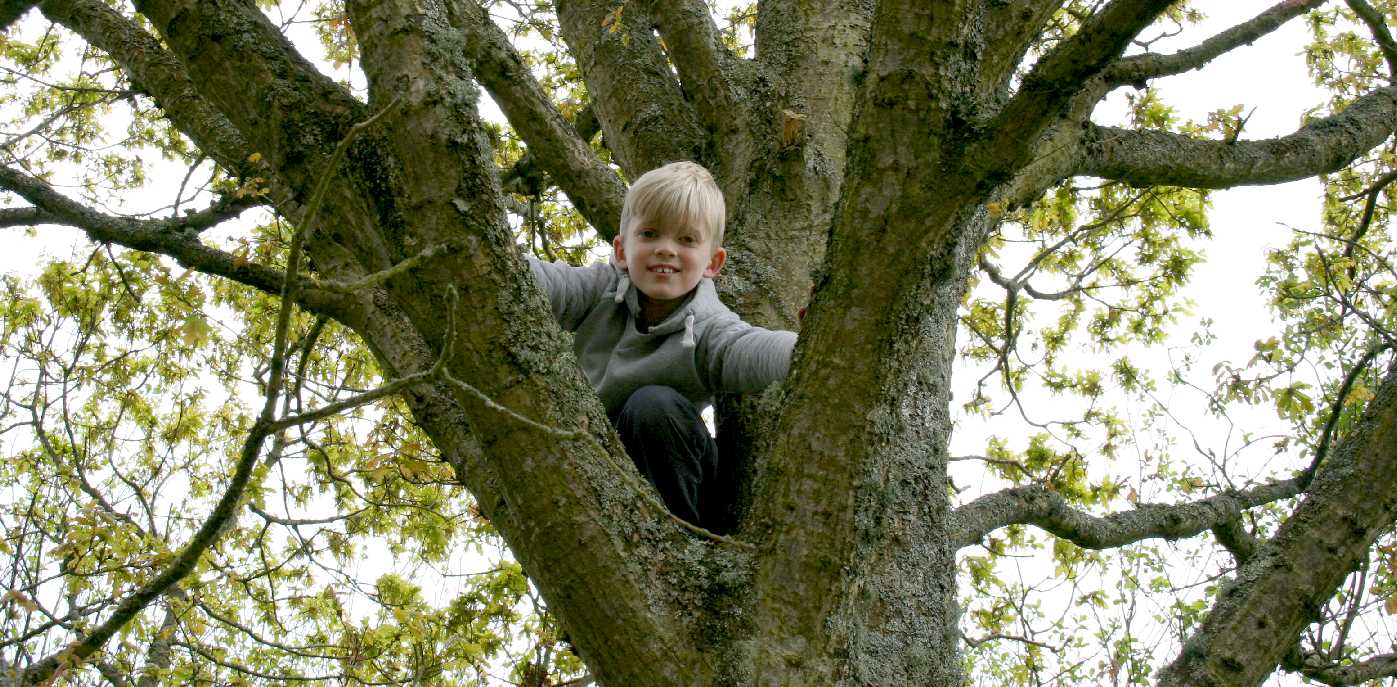
LINKS
http://en.wikipedia.org/wiki/Log_cabin
http://en.wikipedia.org/wiki/Log_house
www.forestry.gov.uk
www.woodforgood.com
Scottish
Construction Centre
Wood
for Good
UK
Timber Frame Association
UK
Forest Products Association
Timber
Trade Federation
Scottish
Sustainable Construction Forum
Scottish
Passive House Centre
Passivhaus
Trust- UK Passive House Organisation
The
Timber Research and Development Association
Sustainable
construction materials

|








